Classification of Villeins in Medieval Sicily[*]
Hiroshi Takayama
Abstract
According to a traditional view, villeins in Norman Sicily consisted of two basic classes, those who owed their lords hereditary service in person and those who owed service with respect to the terms of their tenure of land. Scholars who recently examined relevant terms in Arabic documents seem to share this view. For example, Jeremy Johns showed us a list of Latin, Greek and Arabic words categorized into two groups, a class of “registered” villeins (ḥursh) and a class of “unregistered” villeins (muls), while Alex Metcalfe explains that Arabic and Greek terms to refer to villeins can be resolved into two basic categories, “registered” and “unregistered” families. In this paper, I will make it clear that muls and ḥursh were not a pair of opposite Arabic terms indicating two different classes of villeins, but that muls simply signify those who were not listed in the previous documents.
It has been generally understood, mainly based on studies of France, that a social class of unfree peasants subject to lords through land tenure was formed in Western Europe during the eleventh and twelfth centuries.[1] Marc Block, a well-known French medievalist, considered that most peasants in the Middle Ages had been unfree and in the status of serfdom due to the following three points. First, they had to pay chevage, a kind of poll-money and a symbol of servitude. Second, they could not marry women living outside their lords’ domains unless they got their lords’ permission by making a large payment. Third, they had to pay mainmorte (death duty) to their lords when they bequeathed their property.[2] Hans Kurt Schulze, a German scholar, defines Bauern (sing. Bauer, peasants) in medieval Europe as those who belonged to rural population (as opposed to urban population), and explains that they constituted a quite uniform class as a whole in terms of social function, management style, and lifestyle, although they consisted of various people in free, semi-free, and unfree conditions, and varied greatly in terms of land tenure.[3]
Scholars seem to have divided medieval peasants into slaves, unfree peasants, and free peasants in terms of degree of freedom, and sub-divided unfree peasants into serfs and villeins in terms of degree of dependence on their lords, although these divisions and definitions are quite artificial. As a matter of fact, there were various words supposed to indicate peasants in medieval Europe, and some of them were sometimes ambiguous and polysemous.
It is important for us to clarify here the usage of some frequently used words, modern and medieval, for peasants of Medieval Europe. The English word “serf” (“serf” in French, “servo” in Italian) derives from the Latin word “servus”, while the English word “villein” (“vilain” in French, “villano” in Italian) comes from the Latin word “villanus”.
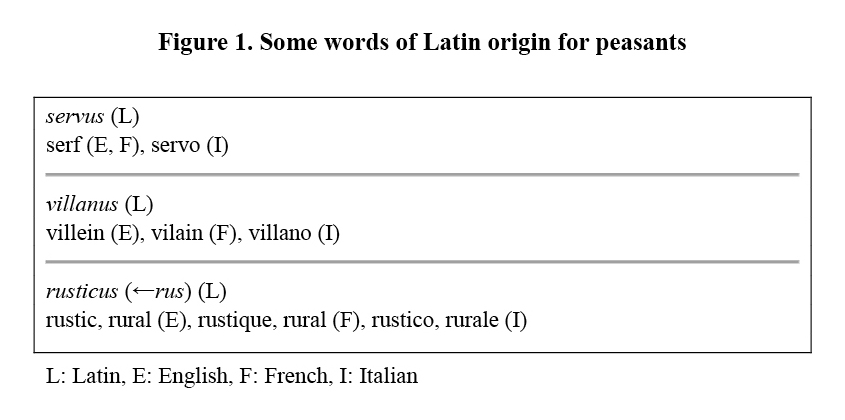
The Latin word “servus”, originally meaning a slave, does not appear very frequently in medieval Latin sources,[4] but “serf” in English or French, and “servo” in Italian, are quite often used by modern scholars to indicate a medieval peasant subject to lords. On the other hand, the Latin word “villanus” originally meant a person in a villa (a village),[5] and “villein” in English (“vilain” in French, “villano” in Italian) is also used to indicate an unfree peasant in medieval Europe. “Villein” is sometimes used almost interchangeably with “serf”. However, some historians think a villein was freer than a serf,[6] while others regard a serf as belonging to one of the two classes of villeins, a more unfree one.[7]
Meanwhile, recent studies seem to suggest that status and condition of peasants in Medieval Europe varied from place to place and from time to time more largely than scholars had previously thought. It is getting more and more difficult for us to consider peasants in medieval Europe as a uniform class of unfree status under lordship.[8]
1. Historiography
The villeins in Norman Sicily have long been investigated by a number of historians, including Rosario Gregorio, Noël des Vergers, Michele Amari, Ferdinand Chalandon, Ernst Mayer, Carlo Alberto Garufi, Illuminato Peri, and Giuseppe Petralia.[9] Scholars mentioned various words in Latin, Greek and Arabic supposed to indicate a villein, and interrelationships between them has been an issue subject to debate. For example, Chalandon, a French historian of the early twentieth century, found various words indicating a villein in the documents of Norman Sicily.[10]
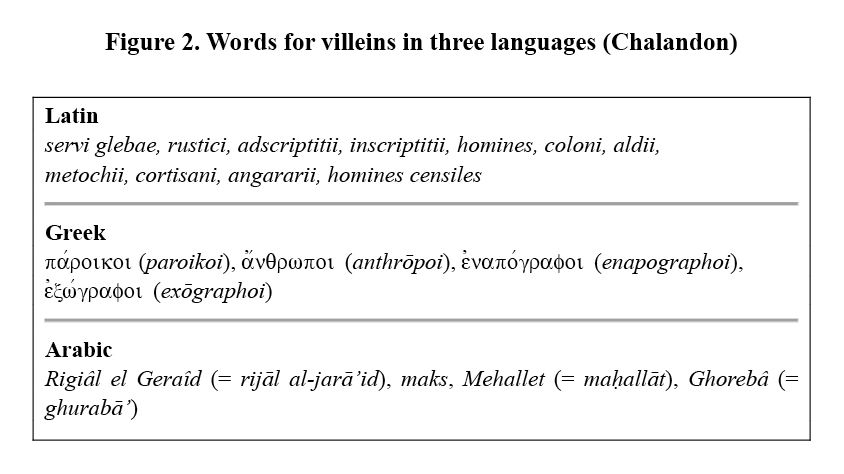
There is no agreement of opinions on which word in Arabic, Greek, or Latin documents corresponds to which word, and there has been controversy over what these words precisely meant. But many scholars seem to have concluded that the villeins consisted of two basic different groups, those who owed hereditary service in person (intuitu personae) and those who owed service with respect to the terms of their tenure of land (respectu tenimenti), based on the following law of William II.
Correcting by a benevolent interpretation the errors of those who say that without their lords’ permission all villeins have been forbidden by royal constitution to enter the clergy, we decree that the villeins forbidden to become clerics by the above-mentioned constitution should be those who are held to serve personally, i.e., with respect to their own persons, like ascriptitii, servi glebe, and others of that kind. However, those who must serve by reason of a holding or other benefice, if they desire to enter clergy, they may do so even without the accord of their lords, after they previously give back what they hold from their lords into the lordsʼ hands.[11]
In this law, the villeins are divided into two categories: “those who are held to personal service, i.e., with respect to their own person, like ascriptitii, servi glebe, and other of that kind,” and those “who owe service by reason of a holding or a benefice.” The law makes clear that the villeins of the first category are forbidden to become clerics while those of the second category may do so even without the permission from their lords.
Based on these descriptions, historians have tried to arrange various words in Latin, Greek and Arabic documents into the two categories. For example, Chalandon, relying on the work of Amari,[12] put them in the following order. In the upper group are the villeins who owe service to their landlords by reason of a holding (respectu tenimenti), that is, homines censiles in Latin, ἐξώγραφοι (exōgraphoi) and ἄνθρωποι (anthrōpoi) in Greek, maks (Amari reads muls as maks)[13] and maḥallāt in Arabic. In the lower group are the villeins who owe service to their landlords with respect to their own persons (intuitu personae), that is, servi and adscriptitii in Latin, ἐναπόγραφοι (enapographoi) and πάροικοι (paroikoi) in Greek, and rijāl al-jarā’id in Arabic.[14]
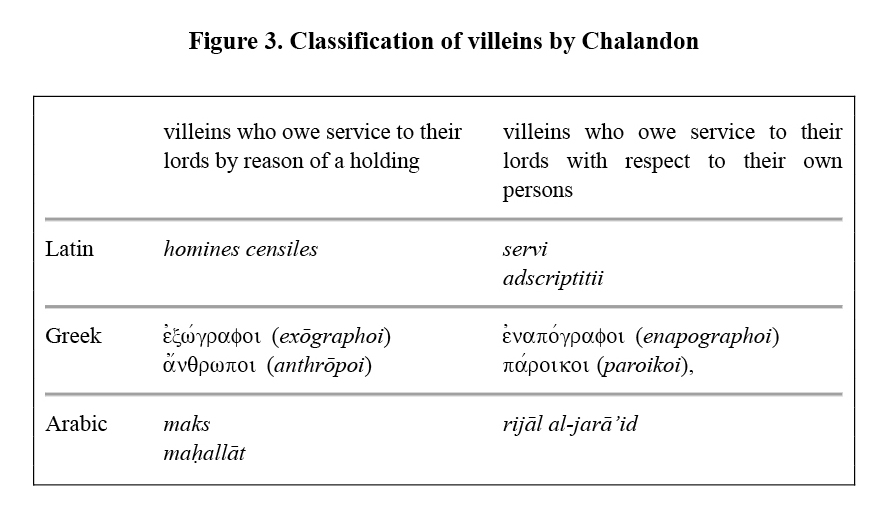
Meanwhile, Carlo A. Garufi, an Italian scholar, explains as follows. Jarīda (pl. jarā’id) included only names of villeins of large estates who owed labor service personally with his family and sons because of their persons, while in the platea (Lat. pl. plateae; Gr. πλατεῖα, pl. πλατεῖαι) included all villeins, more precisely, both those who owed labor service because of their persons and those who owed labor service for the lands and other benefices granted to them.[15]
Although this classification is similar to that of Chalandon, Garufi thinks that jarīda included only those who owed labor service personally but platea included both this kind of villeins and the more free villeins who owed labor service by reason of a land holding. This understanding of Garufi based on the difference between jarīda and platea cannot be accepted, however, because the Arabic word jarīda is written as plateia in Greek in Arabic-Greek bilingual documents, which suggests both are identical.[16]
Although there is no agreement of opinion on which word in Arabic, Greek, and Latin documents relates to which category of villeins, the idea of the classification of villeins into two groups seems to have been accepted by generations of historians.[17] Those scholars who have recently published studies relating villeins in Arabic documents, including Annliese Nef, Jeremy Johns, Alex Metcalfe, and Adalgisa de Simone, also seem to share this idea.[18] For example, Jeremy Johns, who has examined words used for Muslim villeins in Arabic documents in detail, shows us a list of words categorized into two groups.[19]
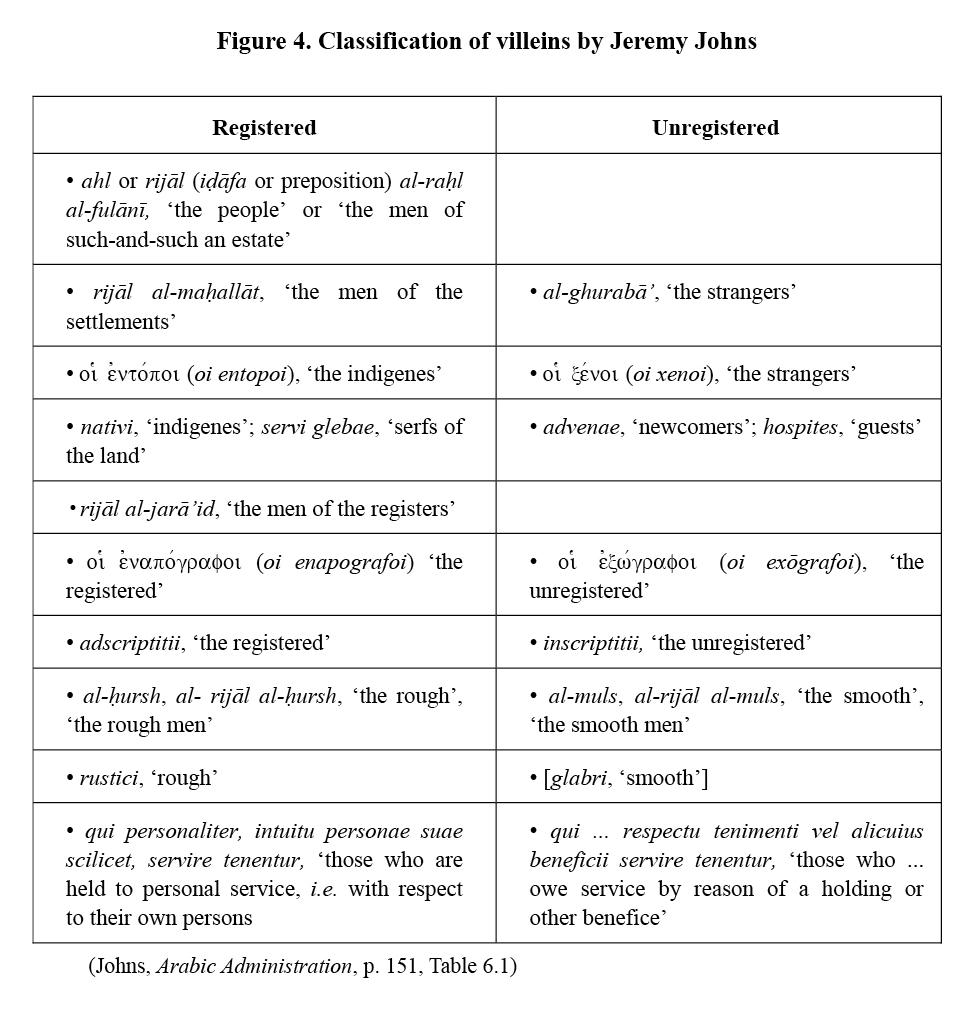
According to him one group is a class of “registered” villeins expressed as ḥursh (the rough men) as well as rijāl (ahl) al-jarā’id (the men of the registers) in Arabic documents, and the other is a class of “unregistered” villeins expressed as muls (the smooth men) in Arabic documents. This summary, a result of Johns’ extensive examination of Arabic parchments in Norman Sicily, shows us his new interpretation and detailed information about Muslim peasants, but he preserves the traditional idea of the classification of the villeins into two groups.[20]
Johns’ understanding of Muslim villeins has been accepted overall by Alex Metcalfe. According to Metcalfe, many terms were used synonymously across three languages to refer to villeins, and those in Arabic and Greek can be resolved into two basic categories: families who were “registered” and those who were “unregistered”. Following Johns’ idea, he explains that those who were “registered” were called ḥursh (“rough men”), or rijāl (ahl) al-jarā’id in Arabic, and enapographoi (ἐναπόγραφοι) in Greek, while those who were “unregistered” were called muls (“smooth men”) in Arabic, and exōgraphoi (ἐξώγραφοι) in Greek.[21]
This categorization of the words of three languages is highly elaborative. However, it should be noted that many of the listed words have been categorized into the two groups, not based on the usage in the documents of Norman Sicily, but on analogy of the meanings of words, or by analogy with East Roman law and usages outside Norman Sicily. In addition, there is a possibility that such words do not correspond one-to-one contrary to the presupposition that words (concepts) indicating peasants correspond one-to-one between Arabic, Greek, and Latin.
Furthermore, the interpretation of Amari and Nef that exōgraphoi, a Greek word correspondent to the Arabic word muls, originally meant “those written outside (the lists) (que’ fuori scritto/ écrites à l’extérieur (des listes)”,[22] and the opinion of De Simone that exōgraphoi means “those added (to the lists)”,[23] call the understandings of Johns and Metcalfe into question.
In this article, I will focus on muls and ḥursh which Johns and Metcalfe have regarded as a pair of opposite words indicating “unregistered” and “registered” villeins, and have given “the smooth men” and “the rough men” as their English translations. I think a new interpretation of muls and ḥursh, as well as rijāl (ahl) al-jarā’id, in Arabic documents will reveal to us a different aspect of the reality of Norman Sicily.
2. muls and ḥursh: a pair of opposite terms?
What is Arabic word muls, then? “Another group of villeins, al-muls,” explains Jeremy Johns, “first appear in contraposition to the rijāl al-jarā’id in the jarīda renewed for San Giorgio di Triocala in November 1141. After the lists of the rijāl al-jarā’id of Triocala and Raḥl al-Baṣal comes a third list of the names of the muls. Muls is the plural of amlas, meaning ‘smooth’, ‘soft’, ‘sleek’, et cetera. ... In the Sicilian documents, however, the word is always used in the plural.”[24]
According to Johns, muls is antithesis to ḥursh. “The muls appear in antithesis to the ḥursh,” continues his explanation, “in the two Chùrchuro documents of 1149 and 1154. Of the five households of Muslim rijāl granted to Chùrchuro, two are ḥursh, and three are muls. The word ḥursh is the plural of the adjectival form aḥrash, meaning ‘rough’, ‘harsh’, or ‘coarse’.... As with muls, only the plural form ḥursh is used for the Muslim villeins of Norman Sicily.”[25]
“The two terms,” concludes Johns, “clearly form a pair of contrasted opposites, the ḥursh and the muls, the ‘rough’ and the ‘smooth’. Neither term, to the best of my knowledge, is employed in this sense anywhere in the Arabic-speaking world, except Sicily.”[26] This understanding of Johns has been accepted by Metcalfe[27] and Nef.[28]
The idea of contraposition of muls and ḥursh had already been shown in the nineteenth century by Reinhart Dozy, who had explained “The muls formed in Sicily a certain class of serfs, while another class had the name of al-ḥursh” without giving any French translation in his Supplement to the Arabic Dictionaries published in 1877-1881.[29]
Dozy’s idea was thereafter accepted by Carlo Alfonso Nallino, an editor and annotator of the second edition of Michele Amari’s Storia dei Musulmani di Sicilia published in 1933-39. In a footnote of this book, Nallino states that “ḥursh (plural of aḥrash), which means rough (ruvidi), is the contrary of the class of the aforesaid muls (smooth [lisci]). Examination of the diplomas leads us to the equivalence of ḥursh to rijāl (ahl) al-jarā’id (people [inscribed] in the platea), that is, villani, adscripticii, and rustici.”[30]
Johns’ understanding of ḥursh and muls is basically based on these scholars’ ideas. The supporting sources of their ideas are the two Arabic documents of 1149[31] and 1154[32], which are two copies of a lost document of 1149. These copies have the same content except the part describing the granted land and the sentence added to the document of 1154 to explain why the copy was made again. The word muls appears only once in these documents. “The total is five men (rijāl) from the district of Iato, among whom two are ḥursh and three muls.”
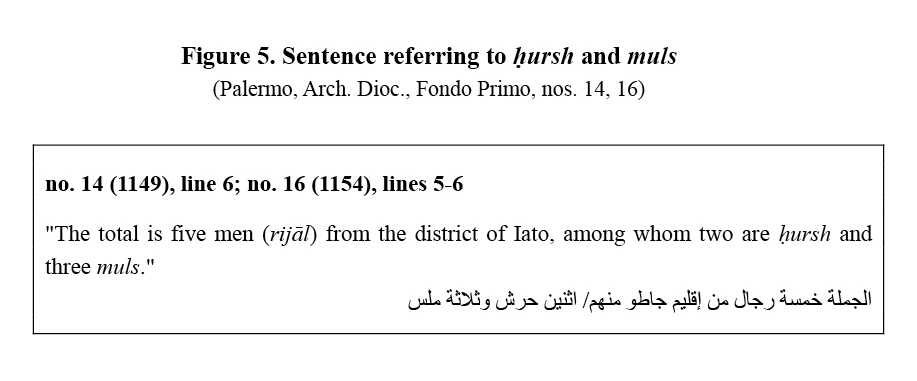
Based on this information, Dozy, Nallino, Johns, and Metcalfe assumed that ḥursh and muls were a pair of opposites. If ḥursh and muls were in fact a pair of opposites, I might have been led to the same conclusion. But, this sentence does not include any detailed information about ḥursh and muls, although they were written side by side. There are no solid grounds to regard these words as a pair of opposites. We should set aside the contraposition of ḥursh and muls, and reexamine what these words really indicated.
3. What is muls?
If ḥursh and muls are not a pair of opposites, how should we understand muls? Muls (sing. amlas) is certainly a word meaning “smoothed (laevis)”, “smooth (glaber)”, “soft (mollis)”, etc., but it is a very ambiguous and polysemous word signifying “mixed (mixtus fuit)”, “escaped (evasit)”, “freed (liberatus fuit)”, “robbed (ereptus fuit)”, etc.[33] Thus, scholars have speculated about its meaning from its apposition with ghurabā’ (ghurbā’)[34] or its contrast to ḥursh (ḥurash).[35] We have only five sources referring to muls.
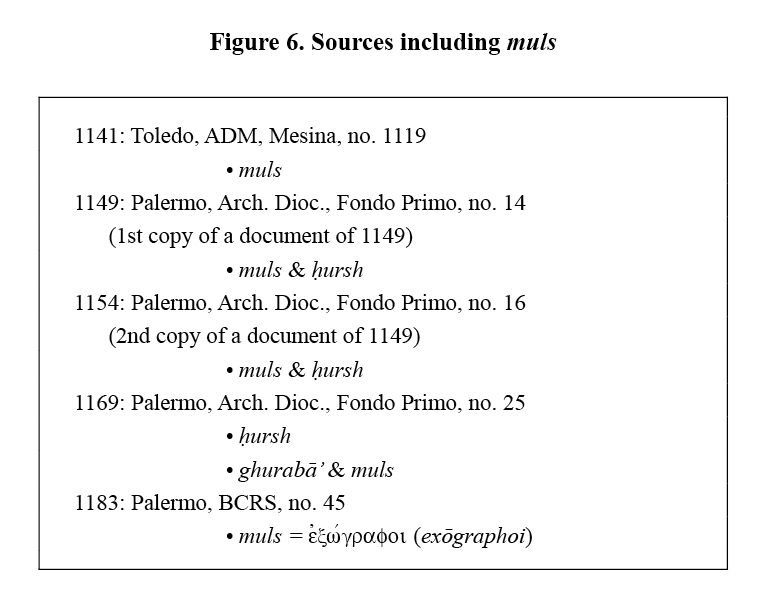
The earliest of them is an Arabic document issued in 1141 and now preserved in an archive in Toledo.[36] The word muls appears twice in this document. The second and third earliest are the Arabic documents of 1149 and 1154, which are the two copies of a lost document of 1149 I have already mentioned. Both are now preserved in an archive in Palermo. The words muls and ḥursh appear once in each of these documents.[37] The fourth earliest is an Arabic-Greek document issued in 1169, now preserved in the same archive in Palermo.[38] This document includes the words ḥursh, ghurabā’, and muls.
The last of the five sources is a long Arabic-Greek bilingual document issued in 1183, and now preserved in another archive in Palermo.[39] It is this Arabic-Greek bilingual document of 1183 that gives us a hint to figure out what the word muls meant. In this document, the Arabic word muls is written as ἐξώγραφοι (exōgraphoi) in Greek. The words muls and ἐξώγραφοι (exōgraphoi) appear repeatedly in this document.
Both muls and ἐξώγραφοι (exōgraphoi) are quite ambiguous words, and it would be difficult to know what a writer intents to indicate by these words in a monolingual document. However, if we can find an overlapping meanings of the Arabic word muls and the Greek word ἐξώγραφοι (exōgraphoi), it would be possible to figure out what the writer intended to mean. The Greek word ἐξώγραφοι (exōgraphoi) has such meanings as “the written outside”, “outside the written”, and “the unwritten” as Amari, Nef, and De Simone suggest,[40] while the Arabic muls has meanings like “smooth”, “slippery”, and “slipped”.
It would be plausible to assume that by these words, the writer of the document intended to indicate “slipped”, that is, “slipped from the former document or name-list”, “those slipped from the former document or name-list”, or “those newly added” as De Simone suggests. This hypothesis seems to be supported by the composition of the document of 1183.

In this document, as a matter of principle, the same contents are usually written in Arabic and Greek alternately line by line, and a subhead, a list of names, and a total number of the names constitute one unit. In many cases a unit of people of maḥallāt of a certain place (for example, Ghār al-Ṣirfī, lines 14-18) and a unit of muls of the same place (for example, Ghār al-Ṣirfī, lines 19-32) make a pair, although for some places there is only one of the two kinds of unit. The Arabic word maḥallāt, which appears repeatedly in the subheads of the former units of the pairs, is a general word to indicate a settlement, and the people of the maḥallāt at Ghār al-Ṣirfī simply indicate the people of the settlement of Ghār al-Ṣirfī.
The Greek word corresponding to maḥallāt is usually μαχαλλέτ (machallet), a transliteration of maḥallāt, and it is also expressed as οἱ ἄνθρωποι μαχαλλέτ (hoi anthrōpoi machallet, people of maḥallāt).[41] In some cases, the word οἱ ἔντοποι (hoi entopoi),[42] which means “born in the land”, or the word οἱ ἐντώπειοι (hoi entōpeioi), which means “people of the land”, are added.[43] There is no word to suggest a class of villeins in the subheads. If muls means a class of villeins, why do none of the subheads of the other units of the pairs have words indicating a class of villeins?
If muls and ἐξώγραφοι (exōgraphoi) simply indicate those who were not written in former documents/name-lists, or those who were newly added, however, it is understandable that the subheads of the pairs of units are asymmetric, and that very general expressions like “men” and “people” are used. The document of 1141, the earliest source including muls, also seems to support this hypothesis.
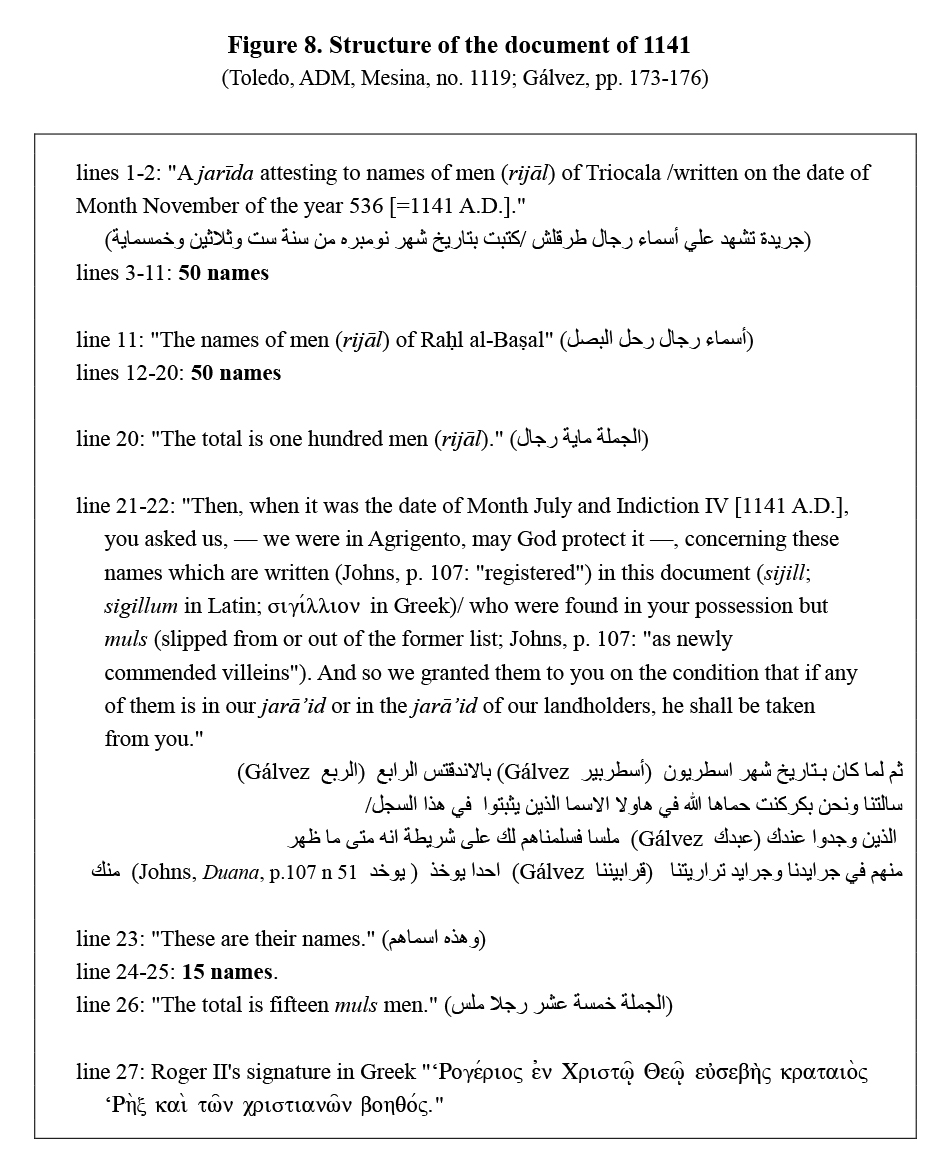
This document includes three name-lists. The first one is the “names of men (rijāl) of Triocala”, the second one the “names of men (rijāl) of Raḥl al-Baṣal”, and the third one the “names written in this document who were found in your possession and muls”. There is no word suggesting a class of villeins in this document either. The word muls appears twice in this document, and could be interpreted as “those slipped from the former lists/documents” as in the case of the document of 1183. The name-lists include names of inhabitants, usually, heads of households.
Already in the eleventh century, Count Roger I of Sicily made use of these name-lists when he granted lands to vassals, churches or monasteries. For example, his Greek-Arabic bilingual document issued in 1095 to grant land to St. Mary Church of Palermo includes name-lists in Greek and name-lists in Arabic[44], and his Greek-Arabic bilingual document issued in the same year to grant land to the bishop of Catania includes a name-list of the people (ahl) of Aci (Aci, Liyāj, Γιάκην) and a name-list of widows (arāmil) in Arabic.[45] Thus, the Norman rulers’ privileges of donation of land often included name-lists of inhabitants (heads of households) living there to confirm that the listed inhabitants should belong to a new lord.
Some of these documents have additional lists of inhabitants, who were not included in the preceding older name-lists, as shown in the documents of 1141 (Figure 8)[46] and 1145 (King Roger II’s approval and renewal of Roger I’s grant of land to his vassal Roger for Walter son of Roger).[47]
This shows that a revision of jarīda was made, not using a method that a completely new name-list was made by rearranging all names based on new information, but by simply putting a new name-list below the old ones. This method of revision seems to support the idea that the words muls and ἐξώγραφοι (exōgraphoi) in the subheads of the name-lists in the document of 1183 were used to indicate the following name-lists were additional. It does not mean that there were different classes of villeins expressed by different words, which were written in different columns. Various words were employed to indicate inhabitants, but most words are generally ones meaning “people” or “inhabitants”. Muls and ἐξώγραφοι (exōgraphoi) are not words indicating different classes of villeins, but documental words meaning “slipped away from” (or “not written”) in former jarīda. This word indicates that they refer to newly added information.
In Arabic documents of Norman Sicily we also see the phrase rijāl al-jarā’id, namely, “men of jarā’id”. Some scholars have regarded it as another antithesis to the muls. For example, Johns explains as follows: “Another group of villeins, al-muls, first appear in contraposition to the rijāl al-jarā’id in the jarīda renewed for San Giorgio di Triocala in November 1141. After the lists of the rijāl al-jarā’id of Triocala and Raḥl al-Baṣal comes a third list of the names of the muls.”[48]
However, al-muls is not in contraposition to the rijāl al-jarā’id in this document. As we have examined before, there is no phrase of rijāl al-jarā’id here. We find only “rijāl of Triocala” and “rijāl of Raḥl al-Baṣal”,[49] which Johns probably interpreted as rijāl al-jarā’id.
Johns and other scholars have regarded rijāl al-jarā’id as a lower class of villeins, and rijāl al-muls as an upper class of villeins. I do not agree to this, because there are no sources showing that the phrase rijāl al-jarā’id indicated a class of villeins. The word muls appears repeatedly in the subheads of the name-lists in the document of 1183, but neither ḥursh nor rijāl al-jarā’id appears in subheads of the name-lists in the documents of Norman Sicily. The phrase rijāl al-jarā’id did not indicate a particular class of villeins, but meant literally “men of documents”, that is, “men written in documents”.
Documents of grant in Norman Sicily often include a conditional clause that if a person whose name is listed in the present document was already listed in another privilege or document, he should be excluded from this donation. For example, a Greek document issued in 1095 has the following sentence: “If someone of the Hagarenes written in this plateia donated to the bishop of Catania is found in my plateiai or the plateiai of my vassals, he should be returned without exception,”[50] and the document of 1141 we have already examined includes the following clause: “If someone of them is included in our jarā’id or the jarā’id of our vassals, he should be taken from you”.[51]
What most matters here is in whose jarīda a peasant is written and to whom he belongs. Classes of villeins do not matter. Making clear and sure to which landlord a peasant belonged was the main purpose of including a name-list of peasants in these documents.[52]
Meanwhile, based on the existence of the two classes of villeins, scholars have posed two interesting questions. The first question is “Who were muls?” For example, Johns assumed that muls were new immigrants. According to his research, fourteen names out of fifteen muls written in a document of Triocala issued in 1141 have nisbas indicating their origin of North Africa. Thus, he infers that “they were new immigrants to the lands upon which they were registered.” And this supposition is, he thinks, supported by the document of 1169 in which muls are paired with ghurabā’ (foreigners).[53] Metcalfe made a slight modification to this view, insisting that we should not regard muls as the first generation of immigrants to Sicily. According to Metcalfe, most of them came from other towns and villages, and received tolerant conditions to hold land, such as reduction of taxes and extension of its payment.[54]
The second question is “Does the legal status of muls change to that of rijāl al-jarā’id in due course of time?” According to Nef, muls were not members of the community in charge of paying tax, but changed to registered rijāl al-jarā’id after they joined the community.[55] On the other hand, Johns assumes that muls were unregistered “strangers” at the beginning, but changed to registered rijāl al-jarā’id after they settled in the land.[56] Metcalfe explains that after the next census, muls ceased to be “unregistered” and were written in a name-list as “men of registers”. Thus, he thinks the class of villeins changed by a census.[57] Needles to say, however, muls, which these scholars regarded as an upper class of villeins, were not a class of villeins, but simply those not written in former documents/ name-lists.
Johns, Metcalfe, and Nef were obliged to explain the change of class from “unregistered men” to “men of registers” based on the existence of the two classes of villeins, but in fact this simply indicates that names omitted or unwritten in former documents/name-lists were added in new documents.
4. What is ḥursh?
If the Arabic word muls is not in contraposition to ḥursh, but simply means omission or those who were not written in former lists, then, what does the Arabic word ḥursh indicate? As of now, no Greek word is known to correspond to the Arabic word ḥursh, and there has been controversy concerning the meaning of ḥursh. Some scholars believed that ḥursh has a relationship with a Latin word rusticus.[58] However, as Amari already pointed out, the conventional idea that ḥursh was an Arabic translation of Latin rusticus is not based on reliable grounds.[59]
Nallino explains that ḥursh, meaning rough (ruvidi), is an antithesis to muls, and that examination of sources leads us to the conclusion that it is the same as rijāl (ahl) al-jarā’id (men written in plateiai), that is, villani, adscripticii, and rustici.[60] Based on this understanding of Nallino, Johns explains that the “word ḥursh is the plural of the adjectival form aḥrash, meaning “rough”, “harsh”, or “coarse”. ... As with muls, only the plural form ḥursh is used for the Muslim villeins in Norman Sicily.”[61]
De Simone reads this word ḥ/r/sh, not as ḥursh, plural form of aḥrash, but as ḥurash, which she thinks the Arabic scribe writing the Arabic documents used as an Arabic translation of the Greek phrase ho/hoi ek tēs khōras (ὁ/οἱ ἐκ τῆϛ χώραϛ) meaning natives, former inhabitants, or old inhabitants. Thus, De Simone proposed a new interpretation that ḥurash and muls indicate old settlers (indigeni) and new settlers (sopraggiunti).[62]
There are only three sources that include ḥursh, all of which I have already mentioned as the documents including muls.
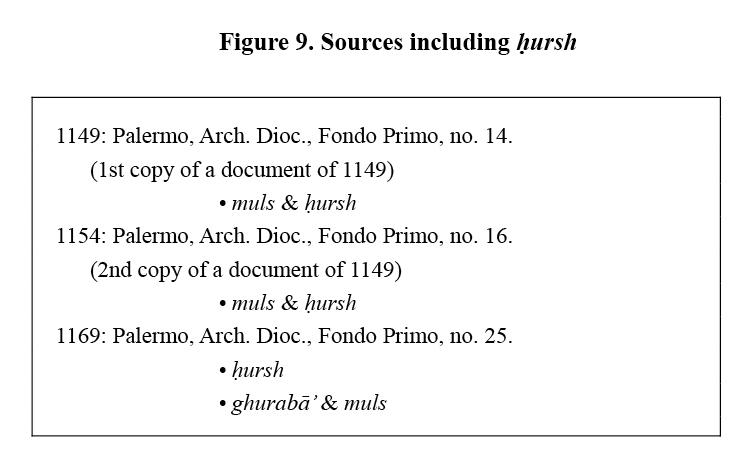
The earliest two documents of 1149 and 1154 are the copies of a lost document of 1149, and have almost the same content. Both have the following sentence as I have already shown in Figure 5: “The total is five men (rijāl) from the district of Iato, among whom two are ḥursh and three muls.” The third source is the Arabic-Greek document of 1169 which includes the words, ḥursh, ghurabā’ and muls, and gives us more detailed infomation.[63]
The introductory Arabic text of this document informs us that an order of King William II was issued to write this document which includes what he grants to a hospital at Khandaq al-Qayruz, that is, a village (raḥl) known as ʻAyn al-Liyān in the district of Termini with all its rights, and ends with the phrase “and in it from al-rijāl al-ḥursh”.
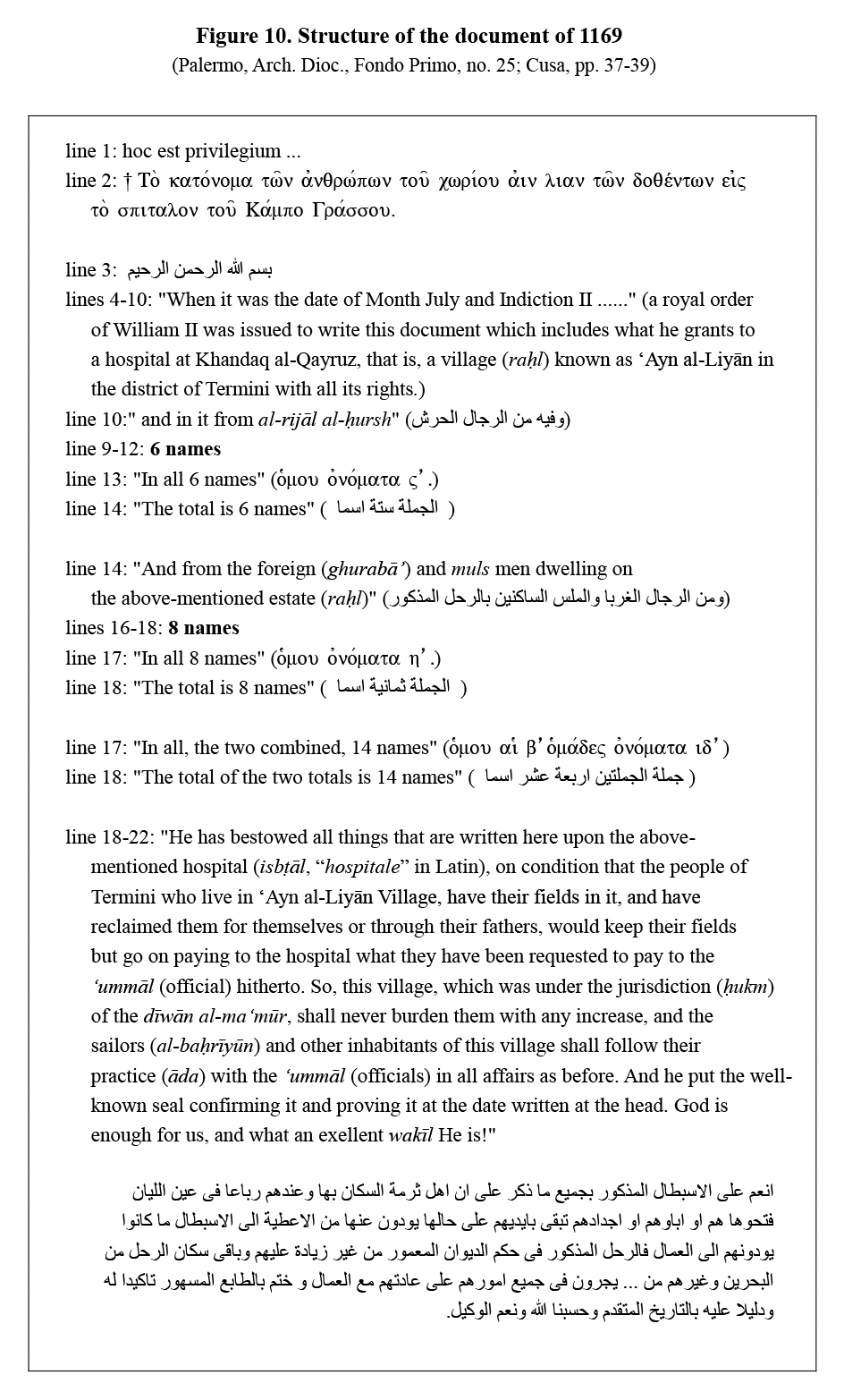
This Arabic text is followed by a list of six names in Greek and Arabic, a phrase “In all six names” in Greek, and an almost same phrase “The total is six names” in Arabic. Then, comes a subhead in Arabic “And from the foreign (ghurabā’) and muls men dwelling on the above-mentioned village (raḥl)”, which is followed by a list of eight names in Greek and Arabic. The Arabic ghurabā’ is a plural form of gharīb meaning “foreign”. In the last sentence lines 18-22 of the document, the king’s order that he shall give all these people to the above-mentioned hospital is described in detail.[64]
As I have already stated, many scholars have regarded ḥursh as a class of villeins in contrast to muls. Johns and Metcalfe gave it an English translation “rough men”, while others think it was used as a translation of the Latin word rusticus. On the other hand, it is possible that ḥursh meant “forest” in the documents.[65] In any case, our information on ḥursh is too limited to get a plausible answer. Further conjecture should not be made.
Conclusion
My conclusion drawn from the examination of sources about the Arabic words muls and ḥursh is that they were not a pair of opposite terms indicating two different classes of villeins. Thus, it would not be proper to translate them as “smooth men” and “rough men” in English. Muls is a word employed to indicate those who were omitted or not written in former documents/name-lists, and a term necessitated in document creation.
This conclusion is rather different from previous scholars’ understandings. At first glance, my view of muls might appear to be similar to the concept of “unregistered” villeins opposite to “registered” villeins, but, in fact, they are based on totally different perceptions. Muls as a word to indicate those who were omitted or not written in older name-lists reflects the reality of document creation, as well as the Norman governance of land and inhabitants by means of written documents made based on Arabic name-lists, but it is not relevant to classes of villeins at all.
On the other hand, the idea of “registered and unregistered” as two classes of villeins is derived from the analogy to the Roman or East Roman laws. It is certainly possible that terms and concepts of a certain society’s legal system are transmitted to another society, but the existence of such terms and concepts does not mean that the legal system of the original society functioned in the recipient society. Without examining the difference of the controlling power and method of governance by Norman rulers and territorial lords who make the legal system function, we would not be able to discuss a uniform system covering various territories.
As a matter of fact, it is difficult to assume the existence of two classes of villeins with legal status applied uniformly in Norman Sicily. Even if the Norman rulers restored order to a certain degree in the eleventh and twelfth centuries, their power was not strong enough to enforce legal status of villeins uniformly across the boundaries of seignorial domains. Despite the law of William II, actual conditions of villeins seem to have varied according to the relationship with their landlords.
The reason why listing names of inhabitants in documents was so important for landlords is because it offered them assurance that these inhabitants belonged to them. It seems to suggest a reality contrary to existence of a uniform legal system and a large-scale census which some scholars have presumed. Landlords’ control of inhabitants in their domains probably continued to function as a basic framework of Norman governance, although Norman rulers tried to centralize their administration.
update record, 03. 02. 2018